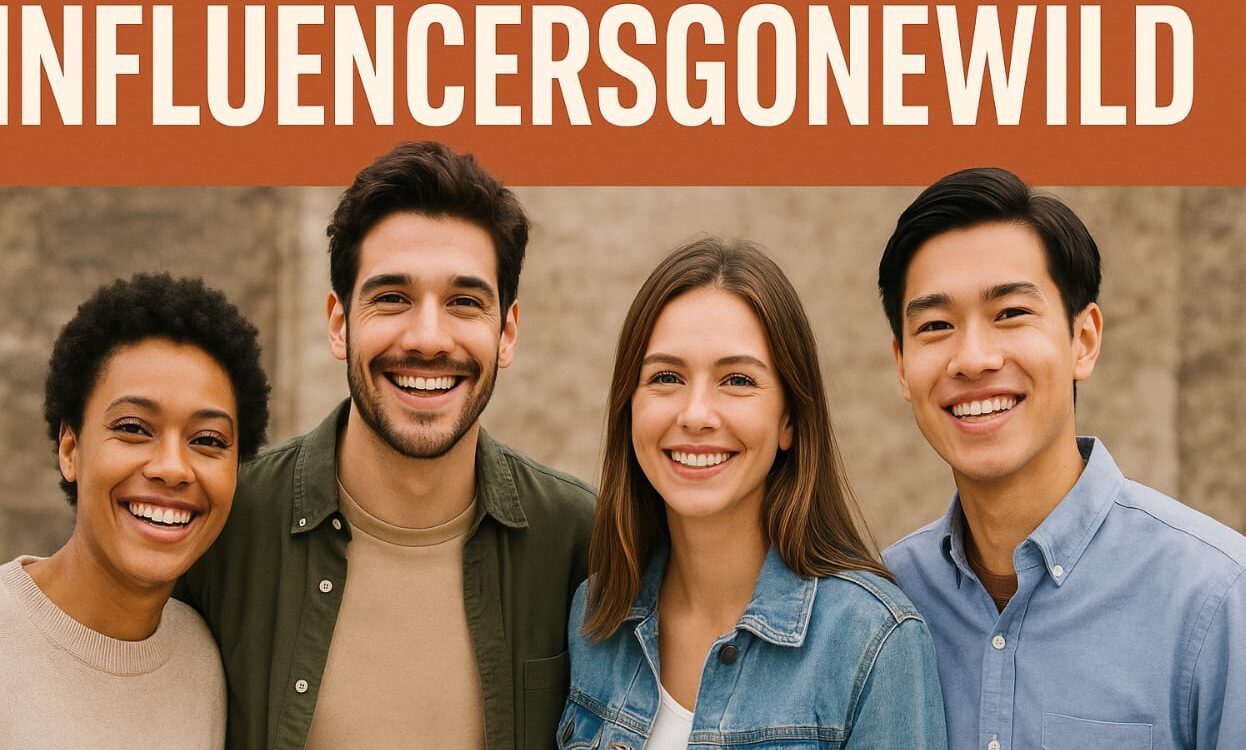Introduction
Nowadays, influencersgonewild has become a trend on social media that quickly grabs people’s attention. It shows the moments when influencers cross their limits—sometimes to go viral and sometimes without thinking. This is not just drama but a signal of how online fame can affect someone’s image and mental state. In this blog, we will review the real meaning, effects, and impact of this trend on society in simple words.
What Does This Word Actually Mean?

- InfluencersGoneWild means those social media influencers who go beyond their normal limits and do things that are either bold or shocking. This content becomes their way of going viral.
- Example: An influencer posts a video on TikTok or Instagram that surprises people — like strange behavior in public, bold outfits, or extreme opinions on a topic.
- Explore Bato Manga like never before on InfluencersGoneWild – where top manga stories meet trending influencer content.
The Impact of Viral Culture and Pressure
- Nowadays, there is pressure on influencers to always have trending and engaging content. When their normal content doesn’t go viral, they adopt “wild” behavior.
- Example: Someone made a simple dance video; it didn’t go viral. The second time they do the same dance in the middle of the beach or in a public place — so that people notice.
An Easy Way to Gain Followers
- This trend has also increased because people quickly become popular with shocking content. People click, comment, and also share.
- Food for thought: Nowadays, people are focusing more on quantity and shock value than the quality of content for attention.
The Role of Social Media Platforms
- Platforms like Instagram, TikTok, or YouTube are not always strong in stopping such content. If the content is going viral and not strictly violating the policy, they don’t remove it.
- Result: Other people are also inspired that they can also go viral by doing this.As long as social media exists, surprises like influencersgonewild will keep happening.
Influencer or Entertainer—The Line Has Ended
- Earlier, people used to think that the job of an influencer was only to promote or educate. Now some influencers have become such that they are followed only for entertainment (that too bold/strange).
- Result: The audience gets confused—are they following someone’s advice or enjoying someone’s crazy videos?
Its Impact on Youth
- Young or underage people consider such influencers as role models. When they try to become like them, they face problems in real life.
- Example: A teenager did a public stunt like his favorite influencer, but it was illegal or dangerous — this thing became a cause of trouble for him.Even in school projects, children are giving presentations using influencersgonewild as an example!
The Problem of Mental Health and Self Image
- Constantly creating shocking and wild content can also disturb the mental health of the influencer. They feel that if they don’t create such content, their career will end.
- Plus: Viewers also feel pressure that they should also do something like this so that people see them.
Damage to Branding and Business
- When an influencer posts wild content, some companies start distancing themselves from them. Advertisers prefer to work with people with a safe image.
- Meaning: Earning money from short-term virality, but the long-term image can be ruined.
Privacy and Legal Issues
Many times, such influencers unknowingly violate someone’s privacy – like posting someone else’s video without permission. Sometimes this is legally punishable.This is also a reason why the “gone wild” label is considered negative.
Audience Response is Changing
Earlier, people only enjoyed such content. Now some people also criticize and report. This means that society is slowly rejecting this behavior.It’s a good signal that people have started to understand the standard of content.
Making Content Viral Through Shock Value
Nowadays, influencers feel that simple or educational content doesn’t go viral. Because of this, they intentionally create shocking or strange content. This is called “shock value”—in” which the audience is attracted by surprising or shocking them.
Creating Fake Drama and Controversy
Many influencers create fake drama for their views and fame – like breakups, fights, or online arguments. This is just a way to gain attention. But this drama slowly destroys their credibility like poison.
Clickbait Titles and Misleading Thumbnails
In the gone wild trend, it is also common for the titles or thumbnails of videos to be exaggerated so that people click. When the content inside is not what the thumbnail shows, trust is broken.
Violation of Boundaries
Wild influencers cross the boundaries of public decency or moral limits — such as inappropriate language, adult jokes, or offensive opinions. They think that the bolder you become, the more viral you will be.
Putting Your Real Life at Risk
For views, some influencers perform extreme public stunts that put their safety at risk — such as making videos on fast-moving trains, or dancing on dangerous rooftops.
Creating a Fake Persona
Influencers who create wild content often hide their real personality and adopt a fake persona that is only for the screen. In the long term, this can cause an identity crisis for them.
Making Social Media Fame an Addiction
When someone gets used to going viral, they look for new shocking ideas every day. This becomes an addiction — just like people are addicted to drugs, they become addicted to viral content.
Loss of Public Image
Once an influencer creates a gone wild image, people stop taking them seriously. Their words have no effect, brands run away, and their career becomes unstable.
The Difference Between Show and Reality
The life these influencers show on social media — luxury cars, expensive lifestyle, bold behavior — is not real. People get confused about what is true and what is just show-off.
A New Era of Online Hate and Trolls
When an influencer creates wild or bold content, they don’t just get likes — people also troll them, create memes, and give hate comments. This can be dangerous for their mental health.
Parental Concern and Youth Misguidance
Parents want their children to follow good role models. But when youth follow such wild influencers, their thinking and behavior go in the wrong direction.
Influencers Also Accept Negative Fame
Many influencers no longer see the difference between positive or negative fame. Their only goal is “to be known in any way.” This thinking is dangerous because they ignore the negative impact.
Blind Trust of Followers
Some people blindly follow every action of influencers. Even if the influencer does something unethical, their fans defend them — this is called blind fandom, which causes social damage.Everywhere, only one thing is trending—yes, the influencersgonewild drama!
Conflict of Content Monetization and Ethics
Sometimes wild content earns more money — YouTube ads, sponsorships, merchandise, etc. But in the pursuit of making money, ethics and values are sacrificed.
The Danger of Cancel Culture
Wild content is sometimes so controversial that people boycott that influencer — this is called “cancel culture.” Because of this, their career can end in a day.
Favoring of Social Media Algorithms
Sometimes platforms like Instagram and TikTok promote wild content more because people react to it — likes, comments, and shares. This algorithm forces influencers to go wild.
Damage to Real-Life Relations and Image
Shocking and bold videos affect the influencer’s friends, family, and even relationships. Not everyone likes someone they know to create such content in public.
Blocking the Path of Long-Term Growth
In the pursuit of short-term virality, the influencer ruins their long-term goals. When the public gets bored of that behavior, that influencer becomes irrelevant — career almost over.
Redemption Stories: Can Influencers Come Back from Scandal?
Yes, some do. And those who handle it well often come back stronger. But the comeback depends on transparency, time, and material growth.
Winning Comeback Strategies
- Genuine, pensive video responses (not Notes app)
- Charitable work or transform
- Step back from monetization, focus on wellness
- Strategic use of YouTube/Podcast platforms for narrative control
Comeback Example: Logan Paul
Post-suicide forest scandal, Paul rebranded as a successful podcaster and WWE performer, recover audience trust.
| Redemption Tool | Perceived Public Value |
| Self-awareness | High |
| Ongoing charity work | High |
| Playing the victim | Low (can backfire) |
It’s possible to turn the tables—but only with effort, honesty, and growth.
What We Can Learn from the InfluencersGoneWild Era
InfluencersGoneWild isn’t just TMZ for the TikTok crowd—it’s a powerful reminder of how fame has changed. In today’s environment, everybody with a phone can become a public figure, and every post could be your last.
Key Takeaways
- Authenticity matters—but so does accountability
- Boundaries must be set between personal life and public persona
- Crowd culture is incalculable, and creators must prepare accordingly
- Digital ethics and awareness are important parts of modern fame
| Theme | Implication |
| Oversharing | Risk of exploitation |
| Monetizing everything | Burnout & backlash risks |
| Fame without support | Mental health dangers |
Creators, platforms, and fans alike must act with more ethics and sympathy in this runaway era of digital influence.
Frequently asked questions (FAQs)
Is every wild influencer bad?
No, not every wild influencer is bad. Some people highlight society’s issues or entertain people through their bold or unique content without negativity. The problem arises when someone does unethical or harmful things just to go viral. The reality is that “wild” doesn’t always mean negative — but intention and impact matter a lot.
What is the real point of the InfluencersGoneWild trend?
The real point of this trend is that people have started doing anything to get limelight in the digital world — whether it’s an odd, shocking, or extreme thing. This is just a way to grab attention in which daring is shown more than creativity.
Does the audience’s response promote this trend?
Yes, when people like, share, and comment on such content, influencers feel that their wild behavior is being liked. In this way, the audience also fuels this trend. If the public boycotts such content, then this trend will naturally decrease.
Can this trend stop in the future?
If platforms become strict, audience awareness develops, and brands support only positive influencers, then this trend can gradually decrease. But as long as people like to see only shock, this trend will not come under full control.
Should new influencers follow this trend?
New influencers should understand that long-term trust is better than short-term fame. You will go viral with wild content, but if your image is damaged, it takes years to rebuild it. That’s why new people should create content thoughtfully.
Conclusion
Today’s digital age is not just about creativity but also about capturing attention. Trends like InfluencersGoneWild have proven that people put their values, ethics, and even their identity at stake to go viral. But the real success belongs to the influencer who leaves a positive impact through content, rather than just taking the limelight with shock value. Every follower also has the responsibility to appreciate truth, goodness, and real talent. When both the audience and creators change their thinking, then social media will truly become valuable.
